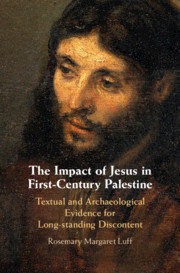Refine search
Actions for selected content:
23990 results in Ancient history
Contents
-
- Book:
- Realities and Fantasies of German Female Leadership
- Published by:
- Boydell & Brewer
- Published online:
- 24 October 2019
- Print publication:
- 01 August 2019, pp v-vi
-
- Chapter
- Export citation
Index
-
- Book:
- Realities and Fantasies of German Female Leadership
- Published by:
- Boydell & Brewer
- Published online:
- 24 October 2019
- Print publication:
- 01 August 2019, pp 375-392
-
- Chapter
- Export citation
13 - Change, Persistence, and Contradiction: The Representation of Female Political Leadership in Gendered Media
- from Part III - Women and Political Power in the Twentieth and Twenty-First Centuries
-
-
- Book:
- Realities and Fantasies of German Female Leadership
- Published by:
- Boydell & Brewer
- Published online:
- 24 October 2019
- Print publication:
- 01 August 2019, pp 262-280
-
- Chapter
- Export citation
6 - Power Struggles between Women in Schiller's and Jelinek's Works
- from Part I - The Age of Enlightened Rule?
-
-
- Book:
- Realities and Fantasies of German Female Leadership
- Published by:
- Boydell & Brewer
- Published online:
- 24 October 2019
- Print publication:
- 01 August 2019, pp 131-144
-
- Chapter
- Export citation
5 - Crossing the Front Lines: Female Leadership, Politics, and War in Die Familie Seldorf
- from Part I - The Age of Enlightened Rule?
-
-
- Book:
- Realities and Fantasies of German Female Leadership
- Published by:
- Boydell & Brewer
- Published online:
- 24 October 2019
- Print publication:
- 01 August 2019, pp 113-130
-
- Chapter
- Export citation
Figures
-
- Book:
- Christianizing Asia Minor
- Published online:
- 07 August 2019
- Print publication:
- 01 August 2019, pp vi-vi
-
- Chapter
- Export citation
9 - Strategic Optimism: Bertha von Suttner's Activism for Peace
- from Part II - Leadership as Social Activism around 1900
-
-
- Book:
- Realities and Fantasies of German Female Leadership
- Published by:
- Boydell & Brewer
- Published online:
- 24 October 2019
- Print publication:
- 01 August 2019, pp 184-203
-
- Chapter
- Export citation
Copyright page
-
- Book:
- Christianizing Asia Minor
- Published online:
- 07 August 2019
- Print publication:
- 01 August 2019, pp iv-iv
-
- Chapter
- Export citation
6 - Aberkios of Hierapolis (Koçhisar) and His Gravestone
-
- Book:
- Christianizing Asia Minor
- Published online:
- 07 August 2019
- Print publication:
- 01 August 2019, pp 147-165
-
- Chapter
- Export citation
Appendix 2 - Dated Eumeneian Formula Gravestones
-
- Book:
- Christianizing Asia Minor
- Published online:
- 07 August 2019
- Print publication:
- 01 August 2019, pp 288-296
-
- Chapter
- Export citation
7 - Age and Purpose: Unmarried Women and Female Agency in the Works of E. Marlitt and Hedwig Dohm
- from Part II - Leadership as Social Activism around 1900
-
-
- Book:
- Realities and Fantasies of German Female Leadership
- Published by:
- Boydell & Brewer
- Published online:
- 24 October 2019
- Print publication:
- 01 August 2019, pp 147-164
-
- Chapter
- Export citation
Part I - The Age of Enlightened Rule?
-
- Book:
- Realities and Fantasies of German Female Leadership
- Published by:
- Boydell & Brewer
- Published online:
- 24 October 2019
- Print publication:
- 01 August 2019, pp 25-26
-
- Chapter
- Export citation
Abbreviations
-
- Book:
- Christianizing Asia Minor
- Published online:
- 07 August 2019
- Print publication:
- 01 August 2019, pp vii-viii
-
- Chapter
- Export citation
7 - Aberkios and the Vita Abercii
-
- Book:
- Christianizing Asia Minor
- Published online:
- 07 August 2019
- Print publication:
- 01 August 2019, pp 166-186
-
- Chapter
- Export citation
10 - Christians for Christians
-
- Book:
- Christianizing Asia Minor
- Published online:
- 07 August 2019
- Print publication:
- 01 August 2019, pp 232-245
-
- Chapter
- Export citation

The Impact of Jesus in First-Century Palestine
- Textual and Archaeological Evidence for Long-standing Discontent
-
- Published online:
- 26 July 2019
- Print publication:
- 15 August 2019
6 - Land and Resource Administration: Farmers, Managers, and Soldiers in the Great Oasis
- from Part II - Managing the Oasis
-
-
- Book:
- The Great Oasis of Egypt
- Published online:
- 12 July 2019
- Print publication:
- 18 July 2019, pp 105-121
-
- Chapter
- Export citation
Part II - Managing the Oasis
-
- Book:
- The Great Oasis of Egypt
- Published online:
- 12 July 2019
- Print publication:
- 18 July 2019, pp 81-132
-
- Chapter
- Export citation
16 - The House of Serenos and Wall Painting in the Western Oases
- from Part IV - An Oasis Culture?
-
-
- Book:
- The Great Oasis of Egypt
- Published online:
- 12 July 2019
- Print publication:
- 18 July 2019, pp 281-296
-
- Chapter
- Export citation
Part III - Trade and Mobility in a Connected Environment
-
- Book:
- The Great Oasis of Egypt
- Published online:
- 12 July 2019
- Print publication:
- 18 July 2019, pp 133-216
-
- Chapter
- Export citation
